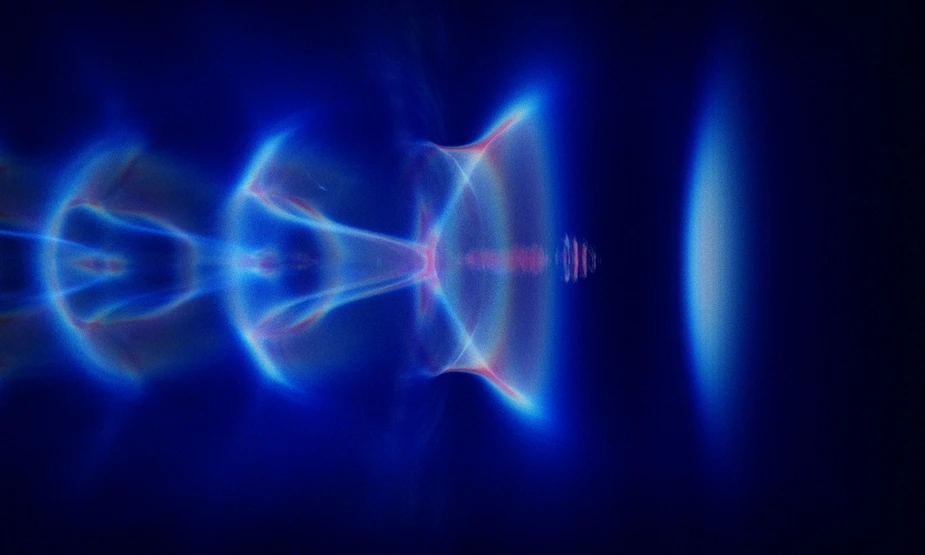Beam diagnostics for future laser wakefield accelerators
Applications of “tabletop particle accelerators” for medicine and research brought closer by a new method which was developed by a team from HZB and PTB
For decades, particle accelerators have been getting bigger and bigger. In the meantime, ring accelerators with circumferences of many kilometres have reached a practical limit. Linear accelerators in the GHz range also require very long construction lengths. For some years now, however, an alternative is explored: "tabletop particle accelerators" based on the laser excitation of charge waves in plasmas (laser wakefield). Such compact particle accelerators would be particularly interesting for future accelerator-driven light sources, but are also being investigated for high-energy physics. A team from Helmholtz-Zentrum Berlin (HZB) and the Physikalisch-Technische Bundesanstalt (PTB) has developed a method to precisely measure the cross-section of electron bunches accelerated in this way. This brings applications of these new accelerator technologies for medicine and research closer.
The principle of laser wakefield accelerators: A high-power laser excites a charge wave in a plasma, which propagates at the speed of the laser pulse and pulls electrons behind it in its "wake", thus accelerating them. Electron energies in the GeV range have been achievable with this technique for some time. However, the electron bunches produced in this way have so far been too small and too poorly focused to use the synchrotron radiation they emit, an intense, coherent light that is used for research in many different disciplines.
For the further development of the technology, a method is therefore needed to precisely measure and control the cross-section and quality of the electron bunches individually. PTB's storage ring, the Metrology Light Source (MLS), allows the generation of small electron bunches in flexible research operation, which are very similar to those of laser wakefield accelerators, but whose properties can be set and varied very reproducibly and precisely. A team at HZB and PTB has now developed a method to measure the lateral expansion of the electron beam of a laser plasma accelerator with a resolution in the micrometre range.
"To do this, we use a technique that is successfully employed at the Bessy II storage ring," explains Thorsten Kamps, co-author of the study. First author Ji-Gwang Hwang had the idea of using the coherent radiation of electron pulses in the visible range via the phenomenon of interference (double slit) and determining the beam cross-section as a deviation from a perfect point source. With the help of a highly sensitive camera and complex algorithms, the team succeeded in measuring the lateral beam size in the range of a few micrometres. Katharina Albrecht carried out the measurements as part of her bachelor's thesis in physics. "We worked very closely with our colleagues from the (MLS) at PTB for this project," Kamps emphasises. "There, it is possible to imitate the electron beam from a plasma accelerator on a beamline and thus test the method under realistic conditions," says Kamps.
Publication
Monitoring the size of low-intensity beams at plasma-wakefield accelerators using high-resolution interferometry
Ji-Gwang Hwang, Katharina Albrecht, Arne Hoehl, Beñat Alberdi Esuain, Thorsten Kamps
Communications Physics (2021). DOI: 10.1038/s42005-021-00717-x
Note
The work described here takes place within the framework of the ATHENA project — „Accelerator Technology Helmholtz Infrastructure“. This is a new research and development platform of the Helmholtz Association for accelerator technologies. Based on innovative plasma-based particle accelerators and state-of-the-art laser technology, two lighthouse projects are to be established: an electron accelerator facility at DESY in Hamburg and a hadron accelerator facility in Dresden. At both facilities, different fields of application are to be developed, ranging from a compact free-electron laser to novel medical applications and new applications in nuclear and particle physics.
Contact:
Physikalisch-Technische Bundesanstalt
Arne Hoehl
Working Group 7.11 IR Spectrometry
Department 7.1 Radiometry with Synchrotron Radiation
Phone: +49 30 3481-7181
Email: arne.hoehl(at)ptb.de
Helmholtz-Zentrum Berlin für Materialien und Energie
Dr. Ji-Gwang Hwang
Department Storage Rings and Beam Physics
Email: ji-gwang.hwang(at)helmholtz-berlin.de
Prof. Dr. Thorsten Kamps
Department High Brightness Beams
Phone: +49 30 8062-15157
Email: kamps(at)helmholtz-berlin.de
Dr. Antonia Rötger
Press Officer
Phone: +49 30 8062-43733
Email: antonia.roetger(at)helmholtz-berlin.de
Joint press release by Helmholtz-Zentrum Berlin (HZB) and Physikalisch-Technische Bundesanstalt (PTB), 30 September 2021
